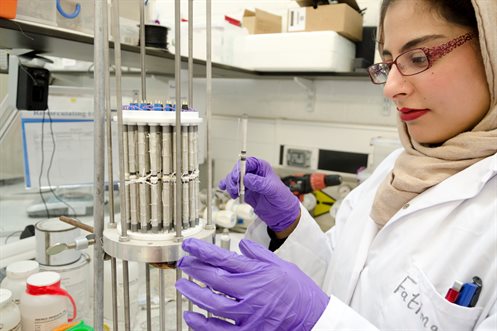That’s cool: on the road to a greener future with new truck refrigeration system
Refrigerated transportation plays a vital role in carrying goods from manufacturing sites to primary storage centres and, from there, to retail stores and other secondary distribution points.
Current refrigerated trucks run on vapour compression systems, powered by a separate auxiliary diesel engine or the main diesel engine itself. Vehicles with internal combustion engines are noisy and emit a considerable amount of greenhouse gases. Even when trucks are stationary, they have to keep their engines idling, which uses up diesel. Fuel cell technology promises to solve these problems, which is why we are working on a way to apply fuel cells to power truck refrigeration systems.
In conjunction with Unilever, we are running a research project called ‘fuel cell integration for refrigeration applications’, which focuses on how to use fuel cell technology in a refrigerated truck (with a gross weight of seven tonnes and above). A slid oxide fuel cell (SOFC) provides the energy to allow the refrigeration system to be on all the time – even when a truck’s engine is switched off. This means no noise and no emissions. In addition to these environment benefits, the SOFC system will reduce wear-and-tear on vehicles and cut diesel consumption.
Besides electricity, a solid oxide fuel cell (SOFC) provides heat, producing temperatures of 650-700°c. Rather than wasting the heat, it can be used to run a thermally driven refrigeration system. What is more; because the SOFC provides a constant source of heat, it allows the refrigerated system to be on all the time, even when a truck’s engine is switched off. This means that in addition to environmental benefits, the SOFC system will reduce wear-and-tear on vehicles and cut diesel consumption.
We are in the process of making a prototype, the first part of which should be built by spring 2016. We are confident we can demonstrate that using fuel cells in trucks can significantly improve and ‘green-up’ the transportation of foodstuffs and other perishable goods.

Mission possible: using fuel cell power systems to extend the flying time of drones
Unmanned aerial vehicles (UAVs) are increasingly being used for a wide range of industrial and commercial purposes, from power line surveillance to documentary filmmaking, as a way to boost efficiency, safety and cut labour costs.
As the demand for civilian-use drones continues to take off, so will the demand for lengthier flight times of UAVs. And that’s where we come in. The four and a half year SUAV project to dramatically extend the mission duration of mini-UAVs is cruising ahead.
Using micro tubular solid oxide fuel cell (SOFC) power system, we are working towards considerably increasing the flight duration of small drones – this reducing mission costs.
In collaboration with 10 companies and universities from seven European countries, SUAV – the first of its kind in Europe, will take to the skies in late 2015; we aim to get our first SOFC-powered drone in the air during November.
Working with Dutch company HyGear and with SURVEY Copter, a subsidiary of our industry partner, Airbus Group, we have taken the existing battery pack from its mini-UAV and swapped it for a fuel cell unit. Whereas the majority of systems are based on polymer electrolyte fuel cells (PEFC’s) using SOFC allows us to use more readily available fuels such as prospane.